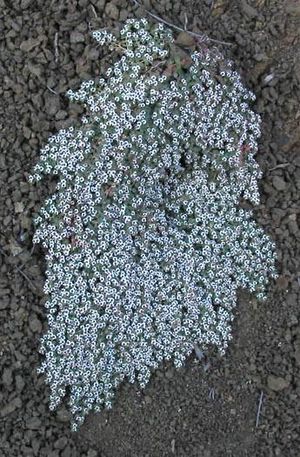Smallseed sandmat facts for kids
Quick facts for kids Smallseed sandmat |
|
|---|---|
 |
|
| Scientific classification | |
| Genus: |
Euphorbia
|
| Species: |
polycarpa
|
| Synonyms | |
|
Chamaesyce polycarpa |
|
Euphorbia polycarpa is a type of plant often called the smallseed sandmat. It's a kind of spurge, which is a large group of plants known for their milky sap. This plant grows naturally in the dry, sandy areas of the southwestern United States and northern Mexico. It's a tough plant that can live for many years, spreading out along the ground like a mat.
Contents
About the Smallseed Sandmat
The smallseed sandmat is a perennial herb. This means it lives for more than two years and has soft stems, not woody ones like a tree. It often grows close to the ground, forming a clump or a mat. Sometimes, its stems might grow a little bit upright.
What it Looks Like
The leaves of Euphorbia polycarpa are quite small. Each leaf is less than a centimeter long. They are usually round or oval-shaped. At the base of each leaf, there are small, triangular parts called stipules.
What looks like a single flower on this plant is actually a group of many tiny flowers. This special group is called an inflorescence. It has many male flowers gathered around one central female flower. White, petal-like leaves called bracts surround this flower unit. These bracts make the plant look like it has pretty white flowers.
After the flowers, the plant produces a small fruit. This fruit is a thin, round capsule. It is less than 2 millimeters wide and covers a tiny seed inside.
Where it Gets its Name
The old name for this plant was Chamaesyce polycarpa. The first part, "Chamae," comes from an ancient Greek word meaning "on the ground." This describes how the plant spreads low and close to the ground. "Syke" is another Greek word, meaning "fig."
Traditional Uses
Some Native American groups have used the smallseed sandmat for different purposes. For example, the Zuni people used this plant to make a warm, thick soup called gruel. They mixed the plant with white cornmeal. This gruel was traditionally used to help mothers produce milk.
Images for kids
See also
 In Spanish: Euphorbia polycarpa para niños
In Spanish: Euphorbia polycarpa para niños


